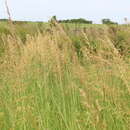Comprehensive Description
provided by North American Flora
Sorghastrum setosum (Griseb.) Hitchc. Contr. U. S. Nat
Herb. 12 : 195. 1909.
Andropogon setosus Griseb. Cat. PI. Cub, 235. 1866.
Andropogon Francavillanus Fourn. Mex. PI. Gram. 56. 1881.
Sorgum nutans micranthum genuinum Hack, in Mart. Fl. Bras. 2^ : 274. 1883. Sorgum nutans micranthum submuticum Hack, in Mart. Fl. Bras. 23 : 275. 1883. Andropogon agrostoides Speg. Anal. Soc. Ci. Argent. 16 : 136. 1883. Andropogon nutans agrostoides Hack, in DC. Monog. Phan, 6 : 529. 1889. Andropogon nutans submuticus Hack, in DC. Monog. Phan. 6 : 529. 1889. Sorghastrum Francavillanum Hitchc. Contr. U. S. Nat. Herb. 12 : 195. 1909. Sorghastrum agrostoides Hitch. Bot. Gaz. 51 : 300. 1911. Stems 1 m. tall or more, glabrous, with the exception of the usually barbed nodes; leafsheaths glabrous, rarely hirsute at the apex; blades up to 5 dm. long and 7 mm. wide, involute or flat, glabrous; panicle 1-2 dm. long, oblong to oblong-linear; spikelets 3.5-5 mm. long, usually yellowish-brown, hirsute, the awn imperfect, 1-3 mm. long, or perfect, the exserted portion not longer than the spikelet.
Type locality : Cuba.
Distribution : Continental tropical America, Jamaica, Cuba, and Haiti,
- bibliographic citation
- George Valentine Nash. 1912. (POALES); POACEAE (pars). North American flora. vol 17(2). New York Botanical Garden, New York, NY
Physical Description
provided by USDA PLANTS text
Perennials, Terrestrial, not aquatic, Stems nodes swollen or brittle, Stems erect or ascending, Stems caespitose, tufted, or clustered, Stems terete, round in cross section, or polygonal, Stem nodes bearded or hairy, Stem internodes hollow, Stems with inflorescence less than 1 m tall, Stems with inflorescence 1-2 m tall, Stems, culms, or scapes exceeding basal leaves, Leaves mostly cauline, Leaves conspicuously 2-ranked, distichous, Leaves sheathing at base, Leaf sheath mostly open, or loose, Leaf sheath smooth, glabrous, Leaf sheath hairy, hispid or prickly, Leaf sheath and blade differentiated, Leaf blades linear, Leaf blades 2-10 mm wide, Leaf blade margins folded, involute, or conduplicate, Leaf blades more or less hairy, Leaf blades scabrous, roughened, or wrinkled, Ligule present, Ligule an unfringed eciliate membrane, Inflorescence terminal, Inflorescence an open panicle, op enly paniculate, branches spreading, Inflorescence solitary, with 1 spike, fascicle, glomerule, head, or cluster per stem or culm, Inflorescence a panicle with narrowly racemose or spicate branches, Inflorescence branches more than 10 to numerous, Flowers bisexual, Spikelets pedicellate, Spikelets sessile or subsessile, Spikelets dorsally compressed or terete, Spikelet less than 3 mm wide, Spikelets with 1 fertile floret, Spikelets with 2 florets, Spikelets paired at rachis nodes, Spikelets 3 per node, Spikelets all alike and fertille, Spikelets in paired units, 1 sessile, 1 pedicellate, Pedicellate spikelet rudimentary or absent, usually sterile, Spikelets bisexual, Spikelets disarticulating below the glumes, Spikelets falling with parts of disarticulating rachis or pedicel, Glumes present, empty bracts, Glumes 2 clearly present, Glumes equal or subequal, Glumes equal to or longer than adjacent lemma, Glume equal to or longer than spikelet, Glume surface hairy, villous or p ilose, Glumes 8-15 nerved, Lemmas thin, chartaceous, hyaline, cartilaginous, or membranous, Lemma 3 nerved, Lemma glabrous, Lemma apex dentate, 2-fid, Lemma distinctly awned, more than 2-3 mm, Lemma with 1 awn, Lemma awn less than 1 cm long, Lemma awn from sinus of bifid apex, Lemma awns straight or curved to base, Lemma margins thin, lying flat, Lemma straight, Palea membranous, hyaline, Palea shorter than lemma, Stamens 3, Styles 2-fid, deeply 2-branched, Stigmas 2, Fruit - caryopsis.

